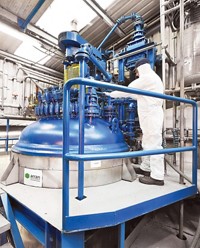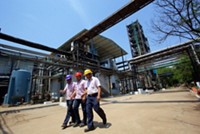Advertisement
Grab your lab coat. Let's get started
Welcome!
Welcome!
Create an account below to get 6 C&EN articles per month, receive newsletters and more - all free.
It seems this is your first time logging in online. Please enter the following information to continue.
As an ACS member you automatically get access to this site. All we need is few more details to create your reading experience.
Not you? Sign in with a different account.
Not you? Sign in with a different account.
ERROR 1
ERROR 1
ERROR 2
ERROR 2
ERROR 2
ERROR 2
ERROR 2
Password and Confirm password must match.
If you have an ACS member number, please enter it here so we can link this account to your membership. (optional)
ERROR 2
ACS values your privacy. By submitting your information, you are gaining access to C&EN and subscribing to our weekly newsletter. We use the information you provide to make your reading experience better, and we will never sell your data to third party members.
Drug Development
Inside the rarefied world of polymer drug manufacturing
The biotech Tricida turned to Patheon for a task few firms can carry out
by Michael McCoy
October 21, 2018
| A version of this story appeared in
Volume 96, Issue 42

The world is a big place. Across its wide expanse are hundreds of facilities where a drug company can have a pharmaceutical active ingredient made to order.
If the active ingredient happens to be a polymer, though, that list of places quickly narrows down, perhaps to just one: an 80-year-old industrial park on the Danube River in Linz, Austria. Within the park is a factory that must be visited by any company seeking to develop a polymer as a drug.
Gerrit Klaerner and Wilhelm Stahl know that factory well. Between them, they have visited it many times as employees of companies that specialize in developing polymers to treat life-threatening illnesses. Today, as executives of Tricida, they are counting on the factory to help bring their latest, and possibly most important, polymer drug to market. Moreover, they want to get it there fast.
Polymer drugs constitute a tiny corner of the pharmaceutical world. Most drugs, be they small molecules or biologics, bind to or otherwise inhibit the action of proteins in the body. Polymer drugs are different. Rather than interact with the body, they stay unabsorbed, capturing unwanted salts or acids in their molecular webs until they are excreted away.
One example is Daiichi Sankyo’s Welchol, a polymer that binds bile acid, which the body makes from cholesterol. Eliminating bile acid prompts the body to make more, reducing cholesterol levels in the process. Another polymer drug is Sanofi Genzyme’sRenvela, which treats chronic kidney disease by sopping up potentially deadly excess phosphates.
Klaerner is a German polymer chemist who has spent most of his career developing polymer drugs. He moved to the U.S. in 1997 for a postdoc in California. When it ended, he got a job at Symyx Technologies, a high-throughput experimentation firm founded by the renowned chemists Peter G. Schultz and Alejandro Zaffaroni.

After about five years, Klaerner started a pharmaceutical spin-off of Symyx called Ilypsa, which set out to invent a competitor to Renagel, a predecessor of Renvela. Drawing on Symyx’s technology and experience in polymer synthesis, Klaerner and his small team developed a new polymer that could bind phosphates better than Renagel. Ilypsa licensed the drug to Astellas Pharma and was later acquired by Amgen for $420 million.
The following year, Klaerner helped launch Relypsa, an Ilypsa spin-off formed to come up with a potassium-binding polymer, also for people with kidney disease. Once again Klaerner was successful. Relypsa won U.S. Food & Drug Administration approval for the drug, called Veltassa, in 2015. The Swiss firm Vifor Pharma acquired Relypsa the following year for $1.5 billion.
Klaerner had already moved on by then. In 2013, eager to try his hand at polymer drugs yet again, he left Relypsa to launch Tricida. The name refers to his third effort as well as the substance the firm seeks to bind: hydrochloric acid, which builds up in people with kidney disease in a condition called metabolic acidosis.
Although Ilypsa and Relypsa were both successful, Klaerner sees Tricida as a culmination of his pursuit of polymer chemistry for kidney disease. The first two drugs treat symptoms of the disease. “Our goal is to have a nonabsorbing polymer that is disease modifying,” he says. “We want to treat both the complications and the underlying reasons for kidney disease.”
Nephrologists have long known that people with kidney disease experience acid buildup, which can accelerate the disease and cause muscle breakdown and bone loss. They typically treat it by administering a sodium or potassium base to neutralize the acid. But the same people often have conditions like hypertension, elevated potassium, and fluid overload that are exacerbated by such bases.
Klaerner knew a polymer could do the same job without introducing unwanted metals or ions; he also knew it wouldn’t be an easy polymer to design. “It was more challenging than potassium and phosphate,” he says. “We had to design a polymer that removed the right type and the right amount of acid from the body.”
Drawing on people he knew from earlier polymer design efforts, Klaerner brought together a dozen Ph.D. chemists and analytical experts in labs in Menlo Park, Calif.In previous efforts to design polymers that bind potassium and phosphates, the scientists had older polymer products like Renagel as guides. “This time there was no template,” Klaerner says.
Yet in September 2014, a year after he assembled the team, Tricida announced the discovery of a drug candidate, called TRC101. Although he won’t disclose the structure, Klaerner calls it a cross-linked amine polymer designed to selectively bind large quantities of protons and chloride ions without binding desirable fatty acids, bile acids, and other ions.
Small club
Only a few polymer-based drugs are on the market.
| BRAND NAME | MARKETER | APPLICATION |
|---|---|---|
| Kayexalate | Sano | Potassium removal |
| Kiklin | Astellas Pharma | Phosphorus removal |
| Renvela | Sano Genzyme | Phosphorus removal |
| Veltassa | Vifor Pharma | Potassium removal |
| Welchol | Daiichi Sankyo | Bile acid removal |
Brand name: Kayexalate
Marketer Sano
Application: Potassium removal
Brand name: Kiklin
Marketer Astellas Pharma
Application: Potassium removal
Brand name: Renvela
Marketer Sano Genzyme
Application: Potassium removal
Brand name: Veltassa
Marketer Vifor Pharma
Application: Potassium removal
Brand name: Welchol
Marketer Daiichi Sankyo
Application: Bile acid removal
Note: List is not complete
Source Companies
The polymer’s “secret sauce,” Klaerner says, is the combination of selectivity for hydrochloric acid and high capacity to absorb it. “That’s where we did all the work.”
After preliminary testing, Tricida submitted TRC101 to FDA in late 2015 for approval to begin clinical trials; it got the OK early the next year, and the need to produce the drug in large quantities was now on its radar.
To lead that effort, Klaerner hired Stahl, someone he knew well. The two first met in 2003 when Klaerner worked for Ilypsa and Stahl worked for Saltigo, which manufactured the polymer in the Ilypsa drug. Later, after Klaerner helped found Relypsa, he hired Stahl to run pharmaceutical operations there. Last year Klaerner hired him yet again to become Tricida’s chief technology officer.
When it came to finding a firm to produce the polymer for late-stage trials, Stahl knew the drill. He and his team assessed the landscape and considered a number of companies, including Saltigo. But Stahl ended up recommending the plant on the Danube River, which he had hired at Relypsa as a backup supplier. Back then, the facility was owned by DSM. These days it’s part of Patheon, a subsidiary of the science service company Thermo Fisher Scientific.
One of the reasons Stahl picked Patheon is Michael Stanek, the firm’s vice president of business management for global active pharmaceutical ingredient (API) services and managing director of the Linz site. Although he’s now in an executive role, Stanek trained in polymer synthesis and earlier in his career worked on the team that manufactured Welchol.
Stanek has nurtured the site’s polymer production capabilities and is proud of his team’s skills, which are fundamentally different from those required for small-molecule drug synthesis. “We’ve seen almost every polymer API that is on the market,” he says. “Making polymer APIs is different. They need a different way of thinking.”
They are also not for the faint of heart. It’s no coincidence, Stanek notes, that the Linz site and Saltigo’s plant in Leverkusen, Germany, were built by chemical companies that have the synthesis and raw material handling skills necessary for making high-purity polymers in large volumes.
For example, after polymerization and chemical modification, the APIs are cleaned with water or solvents. Then can swell significantly and must be thoroughly dried, a process that requires, among other things, fluidized-bed drying technology and solvent-handling skills.
Minimizing foreign particles is also key for polymer drug manufacturing, Stanek says. In small-molecule drug manufacturing, unwanted particles can be removed before the final synthetic step via filtration and crystallization. In contrast, the first step in making a polymer drug yields an insoluble bead. Extreme care must be taken to avoid introducing particles in the many subsequent chemical modification and processing steps.
TRC101 brings its own specific challenges, Stanek says. Still, since signing the contract, the firm has perfected the synthesis and advanced it through increasingly large reactors. That’s crucial, because TRC101—unlike many of today’s highly potent therapies for cancer and other diseases—is likely to be a large-volume drug. Despite the polymer’s efficiency, high doses will be required, as is the case for all polymer drugs. And metabolic acidosis affects 3 million people in the U.S. alone.
If the drug is approved, Tricida anticipates needing tens of tonsof polymer at launch. At peak sales, significantly larger quantities could be required.
After getting the go-ahead from FDA in 2015, Tricida moved quickly through Phase I and II clinical trials. It initiated Phase III trials in September 2017 and in June of this year reported successful results. Along the way the firm raised $150 million from private investors; in July Tricida completed an initial public offering of stock, raising $256 million.
The breakneck pace is how Klaerner likes it. A 40-week safety trial started in May, and Klaerner aims to file a New Drug Application for TRC101 in the second half of 2019. If FDA approves the drug in 2020, as he hopes, it will represent one of the fastest progressions from discovery to market on record.
Bringing a drug to market that quickly requires smooth operations on multiple fronts. The many years of combined experience among Gerrit Klaerner, Wilhelm Stahl, and Michael Stanek mean the manufacturing front is well covered. “Willi and Gerrit are both really demanding compared to other emerging company executives,”Stanek says. “They know exactly what they want.”





Join the conversation
Contact the reporter
Submit a Letter to the Editor for publication
Engage with us on Twitter